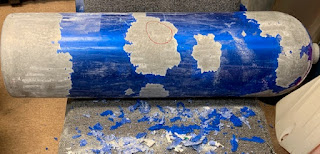Wet or Dry Cylinder Fill? Piercing the Myths
 |
| Poseidon, Greek god of the sea |
Several customers have asked us "Isn't it better to immerse cylinders in water when you fill them?" The short answer is an unequivocal no.
According to Greek mythology, the god Poseidon is responsible for ocean storms. When displeased, he strikes his mighty trident against the earth, wreaking havoc on the high seas. Of course modern sciences like meterology and oceanography clearly explain tsunamis, storms, and typhoons.
 Science also explains quite lucidly why filling compressed gas cylinders in a water-filled bin has disadvantages, but you wouldn't know it by surveying the scuba industry and scuba divers. Myths abound about the advantages of submerging cylinders in water before filling them. This article will burst the bubble surrounding wet fill operations and explain what divers should look for in their local dive shop's fill station operations.
Science also explains quite lucidly why filling compressed gas cylinders in a water-filled bin has disadvantages, but you wouldn't know it by surveying the scuba industry and scuba divers. Myths abound about the advantages of submerging cylinders in water before filling them. This article will burst the bubble surrounding wet fill operations and explain what divers should look for in their local dive shop's fill station operations.
Myth # 1: A metal water-filled bin will contain a cylinder rupture.
Fact: False. It takes a tremendous amount of pressure to compress water. In practical terms, this means that water will not contain flying metal and unless the fill bin is designed to divert energy away from the Fill Station Operator (FSO), the bin will not protect people from flying metal.
------------------------------
Myth # 2: Filling cylinders in water keeps them cool, which means the FSO may fill them faster than if they weren't immersed in water.
 |
| Safely filling O2 and EANx cylinders requires diligence and patience due to cleanliness requirements and slower fill rates. |
- Oxygen: 60 psi per minute
- Nitrox: 200 psi per minute
- Air: 300 to 600 psi per minute
Real world application: You bring in an appropriately marked Nitrox cylinder (6" Nitrox band around the cylinder, current EANx VIP sticker) for a fill. The FSO gauges the cylinder and it reads 400 psi. The cylinder's rated service pressure is 3000 psi.
Question: How long should it take for the FSO to fill your dedicated Nitrox cylinder?
Answer: At least 13 minutes
The math: 3000 psi (service pressure) - 400 psi (pressure before filling) = 2600 psi / 200 psi per minute fill rate = 13 minutes
------------------------------
Myth # 3: Filling cylinders in water keeps them cool throughout the filling process.
Fact: No, not appreciably. It takes 50 minutes for water to have an appreciable cooling effect on steel (3AA) cylinders. It takes 109 minutes for water to cool aluminum cylinders (3AL) because they are much thicker than their steel counterparts.
Myth # 4: Filling cylinders in water cleans the cylinders.
Fact: False. In fact, your cylinder could pick up more salt and gunk from a fill bin full of stagnant water. In effect, you are giving your scuba cylinder a concentrated salt bath. You are much better off rinsing your cylinder post-dive, then having it filled dry.
------------------------------
Myth # 5: Immersing cylinders in water is a good method for detecting leaks during the fill process.
Fact: False. Dunking cylinders in a water-filled bin is a good way to introduce water into the cylinder. A DIN valve can hold 12 to 15 drops of water, a yoke valve 3 to 5 drops. This doesn’t sound like much but is sufficient to begin the corrosion process. BoN divers are smart and understand well why the only thing we want in our cylinders is clean, dry gas.
A better method for detecting leaks is using a spray bottle full of diluted dish soap. A leak will appear as bubbles. If the FSO detects a leak she will stop filling that cylinder, unhook the fill whip, then spray the area again to determine the source of the leak. The culprit is often a valve O-ring. In this case the fix is simple; the FSO will slowly drain the cylinder, remove the valve, clean the crown and O-ring seat on the top of the cylinder, replace the O-ring, and properly torque the valve to specification (usually 50 foot pounds).
------------------------------
What you should expect from your local dive shop's fill operations
 |
| Fill station operators perform many functions to include tapping the side of steel cylinders to listen for a bell-like tone, evidence of a structurally sound cylinder. |
- The FSOs should be trained to PSI-PCI standards for working with compressed gas cylinders.
- FSO personnel should be shielded from potential ruptures.
- Fill whips must be secured and should be only as long as necessary.
- Fill controls should not be above the cylinders. FSOs are at risk of injury if a whip comes loose from its fitting or the cylinder valve.
- The fill station must be equipped with a spray bottle to check for leaks and a hammer to conduct hammer tests on steel cylinders.
- The fill station should be clean and uncluttered.
- The dive shop must maintain fill station and compressor maintenance logs.
- The compressed air lines must be secured every four feet at a minimum.
* My gratitude to Odessa Stratton for editing and improving this article. *





Comments
Post a Comment